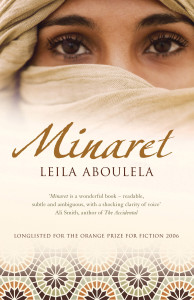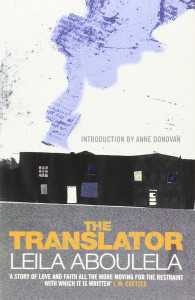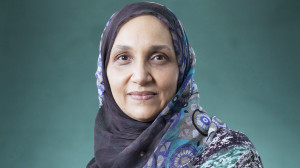Subverting the Stereotypes
By Nudrat Kamal | Books | Published 9 years ago

 In contemporary post-colonial discourse, particularly in the current post-9/11 era, the idea of Muslim identity and the way this identity is created and defined by Muslim writers is one of increasing importance. Muslim writers either become part of the mainstream Orientalist discourse or else try, in varying degrees, to subvert this discourse by creating a counter-discourse. One of the authors whose voice is included in this emerging body of work is Leila Aboulela, a Sudanese who writes in English and has four novels and one short story collection to her name. In her relatively short career, Leila Aboulela has established a significant reputation, winning several literary awards and receiving critical praise from two of Africa’s leading contemporary writers, Ben Okri and J. M. Coetzee. Her work is included in a significant body of research in post-colonialism and feminism.
In contemporary post-colonial discourse, particularly in the current post-9/11 era, the idea of Muslim identity and the way this identity is created and defined by Muslim writers is one of increasing importance. Muslim writers either become part of the mainstream Orientalist discourse or else try, in varying degrees, to subvert this discourse by creating a counter-discourse. One of the authors whose voice is included in this emerging body of work is Leila Aboulela, a Sudanese who writes in English and has four novels and one short story collection to her name. In her relatively short career, Leila Aboulela has established a significant reputation, winning several literary awards and receiving critical praise from two of Africa’s leading contemporary writers, Ben Okri and J. M. Coetzee. Her work is included in a significant body of research in post-colonialism and feminism.
Aboulela stands out from her contemporaries, particularly in the way that her novels help to establish a subversive counter-discourse by opposing Orientalist depictions of Muslim women. Two of her novels, TheTranslator (1999) and Minaret (2005), give voice to two female Muslim characters, and the narrative arcs of both characters subvert mainstream, Orientalist stereotypes of Muslim women in several important ways. Muslim women have been represented in the mainstream western narrative in stereotypical ways. Popular books with titles such as Princess: A True Story of Life Behind the Veil in Saudi Arabia (by Jean Sasson) and Price of Honor: Muslim Women Lift the Veil of Silence on the Islamic World (by Jan Goodwin) all perpetuate damaging Oriental stereotypes about Muslim women.
According to Edward Said, what Orientalist works do is, at one and the same time, characterise the Orient as alien and “incorporate it schematically on a theatrical stage whose audience, manager and actors are for Europe and only for Europe.” Gayatri Spivak (1988) takes this one step further by arguing that in western scholarship the focus is on the Eurocentric subject, which makes the subaltern other anonymous and mute, and prevents the subaltern from having a voice. The popular, mainstream image of Muslim women is that of the mute other — the passive, submissive and oppressed woman who is viewed as a victim instead of as an agent.
In contrast to such Orientalist depictions of Muslim women, Aboulela’s female Muslim characters are depicted to be active agents of their own lives who view their faith as something that empowers instead of oppressing them.The Translator explores the relationship between Sammar, a young Sudanese woman who has recently lost her husband, and Rae, a Scottish academic who gives lectures on post-colonial politics. Sammar works with Rae as a translator of Arabic texts, and over the course of the novel, they develop a romantic relationship. In Aboulela’s depiction, Sammar is shown to be someone who must balance her religious loyalties with her love for Rae. InMinaret, the story revolves around Najwa, an upper-class westernised Sudanese who is forced into political exile in London after a coup. In London she finds a job as a maid with a Muslim family and begins to seek solace and companionship within the Muslim community at the Regent Park’s Mosque. The novel charts her journey from secularism to spirituality and shows how Najwa uses her faith to form a sense of self in a foreign place.
The Islamic veil has been the subject of great controversy in contemporary times. There is a ubiquitous use of the veil as a symbol of Muslim women’s oppression and it is appropriated to advance a taken-for-granted argument of the need to rescue Muslim women from misogynistic Islam. In Minaret, Aboulela presents the veil not as a symbol of Najwa’s oppression but as a tool which Najwa actively utilises to form a stronger, more empowered sense of self and a renewed spiritual identity. “Without it, my nature is exposed,” says Najwa about her hijab. Najwa is drawn to the headscarf because, at a time in her life when everything has changed so drastically, her religion is the one thing she has to hold on to. Wearing the veil, Najwa says, will help her construct a “different version of herself,” one that is “regal like [her] mother, with the skill of concealing rather than emphasising, to refrain rather than to offer.” It is also important to note that Najwa adopts the headscarf not out of compulsion or at the behest of others within the Muslim community — the stereotype that Muslim women are forced to adopt the veil and would choose to be rid of it if they could, is turned on its head by Aboulela. Instead, Najwa adopts the headscarf as a symbol of her devotion to her faith and of her fully embracing Islam as part of her identity.
 However, not all critics agree that Najwa’s adoption of the veil is emancipating. Says critic Esra Santesso, “It is clear enough that even after embracing Islam fully and adopting the head-scarf as a symbol of her devotion, Najwa continues to have an ambivalent relationship with spirituality…[and that] she privately views religion’s strict rules not as liberating but as punitive.” Santesso’s view offers an interesting analysis, but the fact remains that Najwa’s choice to wear the hijab is her own, a choice that shows her agency in a world where little is under her control.
However, not all critics agree that Najwa’s adoption of the veil is emancipating. Says critic Esra Santesso, “It is clear enough that even after embracing Islam fully and adopting the head-scarf as a symbol of her devotion, Najwa continues to have an ambivalent relationship with spirituality…[and that] she privately views religion’s strict rules not as liberating but as punitive.” Santesso’s view offers an interesting analysis, but the fact remains that Najwa’s choice to wear the hijab is her own, a choice that shows her agency in a world where little is under her control.
Moreover, her ambivalence towards her faith in general and her headscarf in particular is a sign of Aboulela’s nuanced portrayal of a Muslim woman’s journey towards religiosity. Instead of portraying her in broad strokes and showing Najwa to be completely unwavering in her devotion to the headscarf, Aboulela instead shows that Muslim women, when following their faith, have individually complex emotional and psychological responses on this journey — responses that might contradict each other at various points. When Najwa wears the headscarf for the first time, she finds it obtrusive. “I didn’t look like myself. Something was removed, streamlined, restrained; something was deflated. And was this the real me?” she thinks to herself. However, as time passes and she eases into her new religious self, Najwa grows accustomed to the headscarf and makes it part of her public identity. By capturing the nuances of Najwa’s adoption of the veil, Aboulela in fact thoroughly obliterates the one-dimensional and static view of the veil as oppressive.
If the underlying idea behind the Orientalist view of the veil as oppressive is that Muslim women are victims, then the same idea pervades another Orientalist view: that Muslim women need to shed their oppressive faith if they are to acclimatise to western “modern” values. In the face of such incompatibility, Muslim women who migrate to the West have no choice but to leave behind their faith in order to fully embrace western values. Thus, the stereotypical western narrative of a Muslim migrant is an emancipatory tale — a journey from religiosity to secularism.
Aboulela, in both The Translator and Minaret, subverts this journey, albeit in different ways. In The Translator, Samar’s faith remains an important part of her sense of self even as she moves from Sudan to Scotland, and in fact her religiosity and her Scottish love interest’s lack thereof is the main conflict keeping the couple apart. InMinaret, Aboulela goes even further — instead of the protagonist holding fast to her faith, her journey is a complete reversal of the western emancipatory tale. Najwa goes from being a secular, westernised upper-class woman of Sudan to a hijab-wearing, deeply religious woman in London.
The Translator, far from perpetuating the Orientalist stereotype of a journey from secularism to religiosity, seems to be written in the vein of Christian narrative forms that were precursors to the novel — stories of conversions and confessions, stories that clarify the divine design at work in worldly affairs.
Aboulela was aware that placing Islamic faith at the centre of her novel would bewilder western audiences. She was often asked why it was necessary for Rae to convert, and why religion was presented as an obstacle. In response, she would refer to Jane Eyre. “From an Islamic point of view, why can’t Mr. Rochester be married to both Bertha and Jane?” she writes. “In the same way that I, as a Muslim reader, respect and empathise with Jane’s very Christian dilemma, I want western/Christian readers to respect and empathise with Sammar’s very Muslim dilemma.” Moreover, Rae’s conversion to Islam and the way Sammar and Rae discuss Islam in the novel also subverts the idea that Islamic societies must convert to western notions of freedom and of secular humanism. According to critic Brendan Smyth, “Rae’s conversion reinforces the validity of Islam as a worldview which offers a promise of social justice and resistance…Sammar and Rae explicitly identify Islam as a religion which offers the potential for liberation and dignity [especially] for the oppressed.”
The Translator also contests the larger Orientalist discourse of white men saving brown women through the relationship of Sammar and Rae. Indeed, it would have been plausible for Aboulela to follow the Orientalist tradition in mapping the trajectory of their relationship — Rae is a Scottish scholar who, while secular himself, is an expert on Islamic discourse. He looks at the Muslim world in a detached, objective way, and in these characteristics he fits in with the Orientalist idea of the West (and western men) being rational and objective. However, even while Aboulela gives him this position, she subverts this notion of Orientalist masculinity as embodied in Rae’s character. Firstly, within the narrative, Sammar explicitly calls Rae out on his Orientalist views and is shown to be uncomfortable with his objective, aloof stance on Islam. “Don’t you realise how much you hurt me by staying objective and detached, like you are above all of this, above me, looking down?” she says to him. Moreover, the notion of Rae as an Orientalist is troubled by the fact that Rae needs a translator to help him understand important Islamic texts written in Arabic. Sammar is employed as his translator, someone who can help him make sense of Islam, both literally and metaphorically.
After refusing to characterise Rae as a typical, Orientalist white hero, Aboulela goes a step further and inverts the notion of the white hero saving the brown woman. Over the course of the novel, it is Sammar who saves Rae on several occasions, both physically and spiritually. Rae is shown to be someone who is not physically strong. This not only contradicts the stereotype of the strong white hero, but also provides the opportunity for Sammar to care for him when he is sick. Additionally, Sammar also saves Rae spiritually, by encouraging him to accept Islam as his faith. While some critics have found Rae’s conversion to Islam at the end of the book a little too contrived and convenient, it is Aboulela’s insistence on his conversion that makes The Translator so subversive. It would have been easier if Rae hadn’t converted — it would have upheld the idea that Islam is a pre-modern religion that no enlightened, educated scholar would willingly choose for himself. Instead, Aboulela shows, through Rae’s conversion, that Islam is a valid alternative worldview that espouses dignity and liberation.
Aboulela is one of the few writers actively working to dismantle damaging Orientalist stereotypes of Muslim women. In doing so, she has joined the ranks of Muslim feminist writers and activists such as Fatima Mernissi, Leila Ahmed and Nawal El Saadawi, although Aboulela’s take on faith and how it can offer liberation and empowerment to women remains unique. In contemporary literature, writers like Aboulela are opening the space for other Muslim women writers to add to the plurality of voices. It is only through a diverse and pluralistic body of work that the Orientalist hegemonic discourse about Muslim women can be effectively
combatted, and it is hoped that Aboulela’s work is just the beginning of the formation of just such a diverse body of work.
Nudrat Kamal teaches comparative literature at university level, and writes on literature, film and culture.


